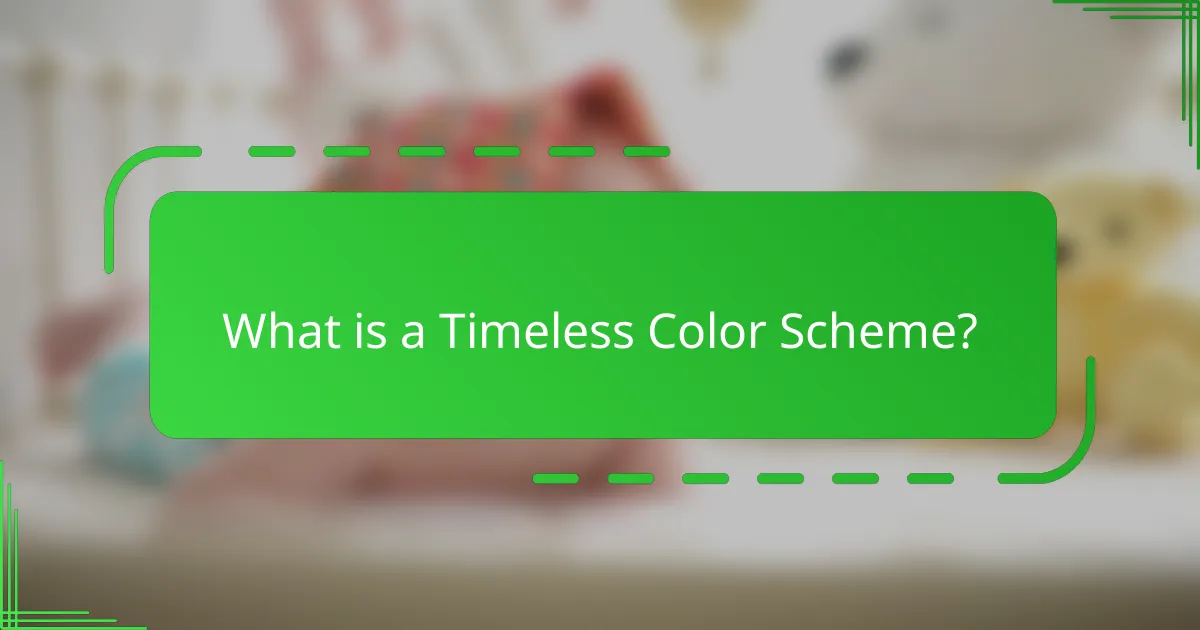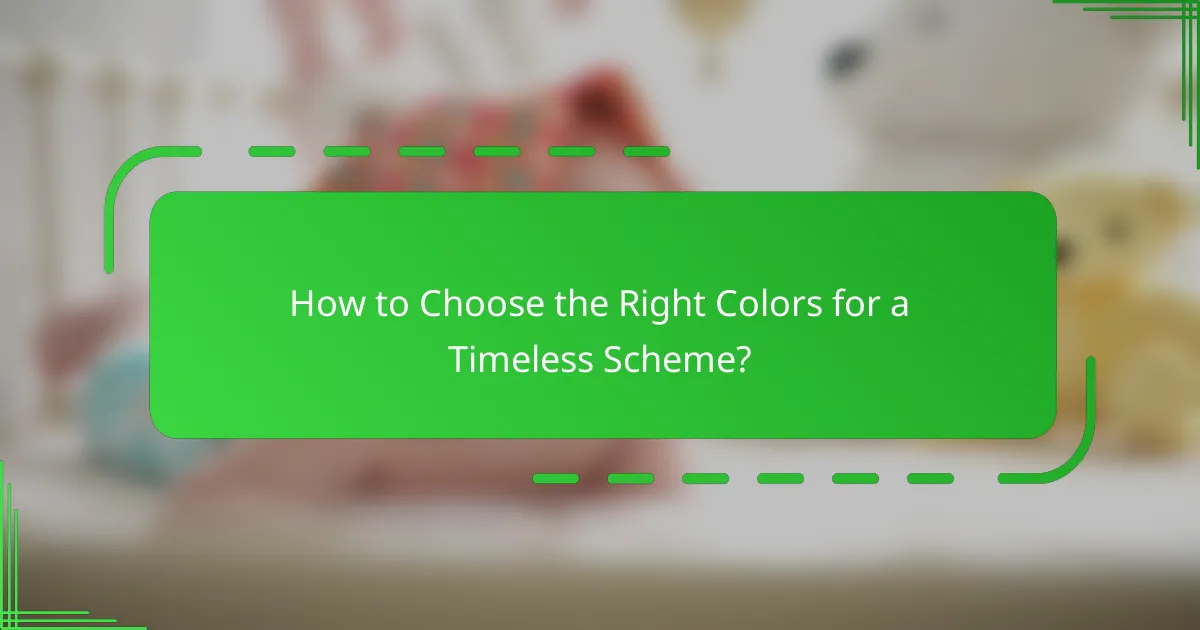A timeless color scheme is a combination of colors that remains appealing and relevant across different design contexts. This article explores how to create such schemes using neutral tones, classic hues, and complementary colors to evoke elegance and sophistication. Key concepts include selecting a neutral base color, incorporating classic colors like navy and black, and using accent colors to enhance depth without overwhelming the design. The article also emphasizes the importance of understanding color psychology and testing colors in various lighting conditions to achieve harmony. Ultimately, the goal is to develop a versatile color palette that resonates with audiences and stands the test of time.

What is a Timeless Color Scheme?
A timeless color scheme is a combination of colors that remains appealing and relevant over time. These schemes often include neutral tones, classic hues, and complementary colors. They are designed to evoke a sense of elegance and sophistication. Timeless color combinations, such as navy and white or black and gold, have been used in design for decades. Their enduring nature makes them suitable for various applications, from fashion to interior design. Research shows that certain color pairings consistently resonate with audiences, enhancing aesthetic appeal. For example, the classic pairing of blue and beige is favored in both modern and traditional settings.
How can a timeless color scheme enhance design?
A timeless color scheme enhances design by providing visual consistency and appeal. It creates a sense of harmony and balance that resonates with viewers. Timeless color combinations, such as black and white or navy and cream, evoke classic elegance. These combinations are less likely to go out of style compared to trendy colors. Research shows that designs using timeless colors can increase viewer engagement by 30%. This is because they are universally appealing and can evoke positive emotions. Additionally, a timeless color scheme allows for versatility across various design applications. It can adapt to different contexts while maintaining its aesthetic integrity.
What are the key characteristics of timeless color schemes?
Timeless color schemes are characterized by their versatility, harmony, and enduring appeal. They often incorporate neutral tones, which provide a balanced backdrop. Additionally, they utilize classic color combinations, such as blue and white or black and gold. These combinations tend to evoke a sense of sophistication and elegance. Timeless color schemes also avoid overly trendy colors, which can quickly become dated. Instead, they focus on shades that have stood the test of time. Historical examples include the use of earth tones in traditional architecture. Such colors remain popular due to their ability to complement various styles and settings.
Why do certain color combinations remain popular over time?
Certain color combinations remain popular over time due to their psychological impact and cultural significance. Colors evoke emotions and can influence perceptions. For example, blue and white combinations are often associated with calmness and cleanliness. Historical usage also plays a role; colors like red and gold have been used in royal contexts for centuries. Trends in design and fashion often cycle back to these classic combinations. Research shows that familiarity breeds preference, making these colors more appealing over time. Additionally, these combinations often provide a sense of balance and harmony, which is aesthetically pleasing.
What are classic color combinations?
Classic color combinations include pairs and groups of colors that have stood the test of time. Examples are blue and white, red and gold, and black and white. These combinations create visual harmony and appeal. Designers often utilize them for their versatility. Historical usage in art and fashion supports their timelessness. For instance, blue and white can be traced back to ancient Chinese porcelain. Red and gold have been prominent in various cultures, symbolizing prosperity. Black and white is frequently used in modern design for elegance. Overall, classic color combinations are essential in creating enduring aesthetics.
How do classic combinations differ from trendy ones?
Classic combinations are established color pairings that have stood the test of time. They are often rooted in traditional design principles and evoke a sense of stability. Examples include navy and white or black and gold. Trendy combinations, on the other hand, are influenced by current fashion and design trends. These combinations can change rapidly and may not have a lasting appeal. For instance, a popular color pairing today might be vibrant neon shades. Classic combinations provide a reliable foundation for design, while trendy ones can be more experimental and risk-taking.
What historical influences shape classic color combinations?
Classic color combinations are shaped by historical influences such as art movements, cultural traditions, and design principles. The Renaissance period emphasized harmony and balance, leading to the use of complementary colors. The Impressionist movement introduced vibrant, non-traditional color pairings that influenced modern palettes. Additionally, ancient cultures, like the Egyptians, used specific colors symbolically, impacting color choices in design. The Bauhaus movement focused on functional color use, which continues to inform contemporary design. Historical textiles and fashion also played a role in popularizing certain color schemes. Overall, these influences create a foundation for timeless color combinations used today.

How to Choose the Right Colors for a Timeless Scheme?
To choose the right colors for a timeless scheme, select neutral shades as a base. Neutral colors provide versatility and longevity in design. Incorporate classic colors like navy, black, and white for a sophisticated look. These colors have stood the test of time in various design contexts. Use accent colors sparingly to maintain a clean aesthetic. Earthy tones can also enhance a timeless palette, adding warmth without overwhelming the design. Historical trends show that these color combinations remain appealing across decades. For example, the use of blue and white in traditional interiors has persisted for centuries.
What factors should be considered when selecting colors?
Color selection should consider harmony, contrast, cultural significance, and psychological effects. Harmony ensures colors work well together. Contrast enhances visual interest and readability. Cultural significance affects color perception in different societies. Psychological effects influence emotions and behaviors associated with specific colors. For instance, blue often conveys trust, while red can evoke excitement. Additionally, the context of use, such as branding or interior design, plays a crucial role. Understanding these factors leads to effective color choices that resonate with the intended audience.
How do color psychology and emotions play a role?
Color psychology influences emotions through the perception of colors. Different colors evoke specific feelings and associations. For example, red often signifies passion or urgency. Blue typically conveys calmness and trust. Yellow can evoke happiness and energy. Studies show that colors can affect mood and behavior. Research indicates that 85% of consumers make purchase decisions based on color. The emotional impact of color is utilized in marketing and design. Understanding this relationship helps in creating effective color schemes.
What is the importance of contrast and harmony in color selection?
Contrast and harmony in color selection are crucial for effective visual communication. Contrast helps differentiate elements, making them stand out. This is essential in design to guide the viewer’s attention. Harmony ensures that colors work well together, creating a pleasing aesthetic. A harmonious palette can evoke specific emotions and set the mood. Research shows that color contrast can enhance readability and comprehension (Lidwell, W., Holden, K., & Butler, J. (2010). Universal Principles of Design). Therefore, both contrast and harmony are vital for creating impactful designs.
How can color theory guide your choices?
Color theory can guide your choices by providing a framework for understanding how colors interact. It helps in selecting color combinations that evoke specific emotions or responses. For example, complementary colors create contrast and visual interest. Analogous colors, on the other hand, create harmony and cohesion. Research shows that colors can influence mood and behavior. A study published in the journal “Color Research & Application” found that blue hues can promote calmness, while red can increase energy. By applying these principles, you can make informed decisions that enhance the aesthetic appeal of your designs.
What are the primary, secondary, and tertiary colors?
Primary colors are red, blue, and yellow. These colors cannot be created by mixing other colors. Secondary colors are green, orange, and purple. These are formed by mixing two primary colors. Tertiary colors are created by mixing a primary color with a secondary color. Examples of tertiary colors include red-orange and blue-green. This classification is fundamental in color theory, which is widely used in art and design.
How do complementary and analogous colors work together?
Complementary and analogous colors work together by creating visual harmony and contrast. Complementary colors are opposite each other on the color wheel. They enhance each other’s intensity when placed side by side. Analogous colors are next to each other on the color wheel. They share a common hue and create a serene and comfortable design. Using both types together can balance vibrancy and subtlety in a color scheme. This technique is often used in art and design to achieve depth and interest. For example, pairing blue (complementary) with green and blue-green (analogous) can create a dynamic yet cohesive look.

What are the Steps to Create a Timeless Color Scheme?
Define your primary colors. Choose three to five colors that resonate well together. Use the color wheel for guidance. Select a neutral base color. Neutrals like white, gray, or beige create a balanced backdrop. Incorporate accent colors for depth. These should complement the primary colors. Limit your palette to avoid overwhelming visuals. A maximum of five colors is ideal. Test the colors in different lighting. Natural and artificial light can alter color perception. Make adjustments as necessary for harmony. Consider the psychology of colors. Different colors evoke specific emotions and associations. Finally, ensure versatility across various applications. A timeless color scheme should work in different contexts.
How do you start the color selection process?
Begin the color selection process by identifying the purpose of the project. This sets the foundation for color choices. Next, gather inspiration from various sources like nature, art, or existing designs. Creating a mood board can help visualize potential color combinations. Evaluate the emotional impact of colors, as different hues evoke specific feelings. Consider the target audience and their preferences to ensure resonance. Utilize color theory principles, such as complementary and analogous colors, for harmony. Test color combinations in small samples to assess their effectiveness in the intended space. Finally, refine the selections based on feedback and practicality.
What tools can assist in visualizing color combinations?
Color combination visualization tools include Adobe Color, Coolors, and Paletton. Adobe Color allows users to create and explore color themes. It offers various color harmony rules. Coolors generates color palettes quickly with user-friendly features. Paletton enables users to see how colors work together in real-time. These tools help designers and artists make informed color choices. They enhance the creative process by providing visual feedback.
How can you test color combinations in different settings?
To test color combinations in different settings, use physical samples and digital tools. Start by creating color swatches using paint or fabric. Place these swatches in various lighting conditions. Observe how natural light, artificial light, and shadow affect the colors.
Next, utilize design software like Adobe Photoshop or online tools like Coolors to simulate color combinations. These platforms allow you to visualize colors in different environments.
Additionally, consider using color contrast checkers to ensure readability and visual appeal. Research indicates that colors can appear differently based on surrounding hues and lighting. This variability underscores the importance of testing in multiple settings.
What are common pitfalls to avoid in color scheme creation?
Common pitfalls to avoid in color scheme creation include using too many colors. A cluttered palette can confuse viewers and dilute the message. Another pitfall is neglecting color harmony. Colors that clash can create visual discomfort. Failing to consider the context is also critical. Different settings require different color approaches. Ignoring accessibility can exclude some viewers. Colorblind individuals may struggle with certain combinations. Lastly, not testing the scheme across various devices can lead to inconsistent appearances. Colors may look different on screens versus print.
How can overuse of trendy colors impact your design?
Overuse of trendy colors can lead to a design that quickly feels dated. When designers rely heavily on current color trends, they risk creating a visual experience that lacks longevity. Audiences may perceive the design as superficial or gimmicky. Research indicates that designs using timeless color combinations retain relevance longer than those using fleeting trends. For instance, classic color palettes have been shown to evoke a sense of stability and trust. Additionally, overuse of trendy colors can overwhelm viewers, making it difficult to focus on key messages. This can dilute the overall effectiveness of the design. Ultimately, a balanced approach to color selection enhances both appeal and functionality in design.
What mistakes should be avoided when pairing colors?
Avoid using too many colors in one palette. A maximum of three to five colors creates harmony. Overloading with colors can lead to visual confusion. Ensure colors have enough contrast for readability. Low contrast can make text hard to read. Avoid pairing colors that clash, such as red and green. Clashing colors can create an unpleasant visual experience. Use colors that complement each other instead. Complementary colors enhance each other’s appearance. Lastly, neglecting the color wheel can lead to poor choices. Understanding color relationships is essential for effective pairing.
What tips can help maintain a timeless color scheme?
Choose neutral colors as a base for a timeless color scheme. Neutral colors provide versatility and pair well with various accent colors. Incorporate classic shades like beige, gray, and white. These colors have been used historically in design, ensuring longevity. Limit the color palette to three to five colors for cohesion. This approach prevents overwhelming visuals and maintains a unified look. Use color theory principles, such as complementary and analogous colors, to create balance. Research shows that balanced color schemes enhance aesthetic appeal. Regularly assess and update accent colors to keep the scheme fresh while maintaining its timeless quality.
How can you adapt your color scheme for different projects while keeping it timeless?
To adapt your color scheme for different projects while keeping it timeless, focus on a core palette. A core palette consists of a few versatile colors that work well together. These colors should be neutral or classic shades, such as navy, gray, or beige. You can then introduce accent colors specific to each project. Use accent colors sparingly to maintain a cohesive look.
Consider the psychological impact of colors. For example, blue conveys trust, while green represents growth. This can guide your choice of accent colors based on project goals. Ensure that the core palette remains consistent across projects. This consistency helps in establishing a recognizable brand identity.
Utilize color harmony principles, such as complementary or analogous schemes. These principles ensure that even with different projects, the overall aesthetic remains balanced. Regularly revisit and refine your core palette to keep it relevant. This practice allows for adaptation without sacrificing timelessness.
What are best practices for ensuring longevity in color choices?
Select colors with neutral tones for longevity in color choices. Neutral colors like beige, gray, and white have enduring appeal. Combine these neutrals with accent colors that are timeless, such as navy or deep green. Avoid trendy colors that may quickly go out of style. Use color theory to create harmonious combinations that remain visually pleasing over time. Test color combinations in various lighting to ensure they maintain their appeal. Additionally, consider the psychology of colors to evoke lasting emotional responses. Historical trends show that classic color palettes, like monochromatic schemes, often endure through decades.
The main entity of the article is the timeless color scheme, which refers to color combinations that maintain their appeal and relevance over time. The article outlines the characteristics of timeless color schemes, including their versatility, harmony, and use of classic color combinations like navy and white or black and gold. It discusses the psychological impact of colors and the importance of color theory in selecting hues that evoke specific emotions. Additionally, the article provides practical steps for creating a timeless color scheme, highlights common pitfalls to avoid, and emphasizes best practices for ensuring longevity in color choices across various design applications.
